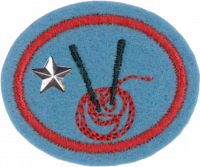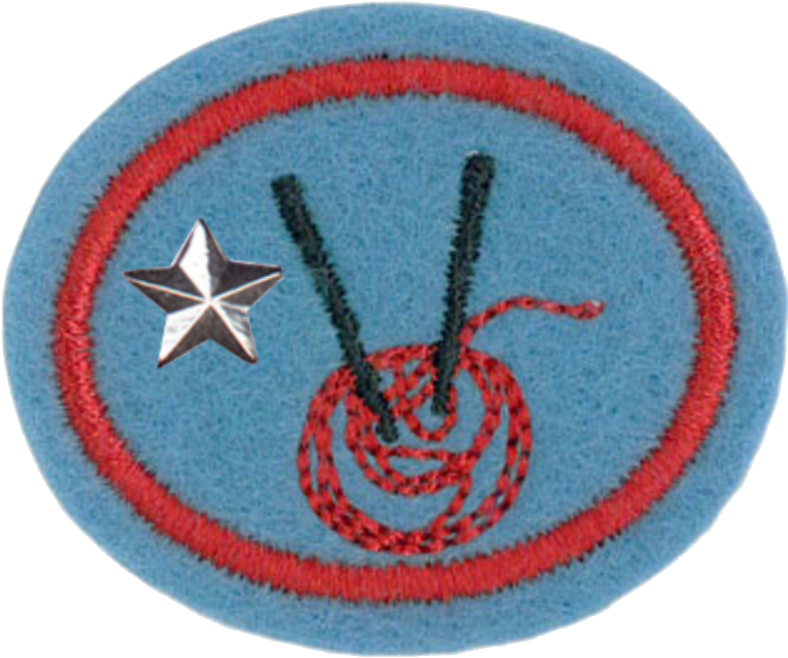Difference between revisions of "AY Honors/Knitting - Advanced/Answer Key 2/es"
From Pathfinder Wiki
< AY Honors | Knitting - AdvancedAY Honors/Knitting - Advanced/Answer Key 2/es
(Created page with "</noinclude> ==Referencias== <noinclude>") |
(Updating to match new version of source page) |
||
| (9 intermediate revisions by one other user not shown) | |||
| Line 1: | Line 1: | ||
{{HonorSubpage}} | {{HonorSubpage}} | ||
<section begin="Body" /> | <section begin="Body" /> | ||
| − | {{ansreq|page={{#titleparts:{{PAGENAME}}|2|1}}|num=1}} | + | {{ansreq|page={{#titleparts:{{PAGENAME}}|2|1}}|num=1|page=AY Honors/Knitting - Advanced/Requirements 2}} |
| − | <noinclude> | + | <noinclude></noinclude> |
| − | </noinclude> | + | <!-- 1. Tener la especialidad de Tejer. --> |
| − | <!-- 1. | + | {{honor_prerequisite|displayname=Tejer|honor=Knitting}} |
| − | {{honor_prerequisite|honor=Knitting}} | + | <noinclude></noinclude> |
| − | <noinclude | ||
| − | |||
{{CloseReq}} <!-- 1 --> | {{CloseReq}} <!-- 1 --> | ||
| − | {{ansreq|page={{#titleparts:{{PAGENAME}}|2|1}}|num=2}} | + | {{ansreq|page={{#titleparts:{{PAGENAME}}|2|1}}|num=2|page=AY Honors/Knitting - Advanced/Requirements 2}} |
| − | <noinclude> | + | <noinclude></noinclude> |
| − | </noinclude> | + | <!-- 2. Tejer una muestra de calibre con el estambre de su elección y las agujas recomendadas en la etiqueta del estambre de la siguiente manera: --> |
| − | <!-- 2. | ||
| − | |||
<noinclude></noinclude> | <noinclude></noinclude> | ||
{{CloseReq}} <!-- 2 --> | {{CloseReq}} <!-- 2 --> | ||
| − | {{ansreq|page={{#titleparts:{{PAGENAME}}|2|1}}|num=3}} | + | {{ansreq|page={{#titleparts:{{PAGENAME}}|2|1}}|num=3|page=AY Honors/Knitting - Advanced/Requirements 2}} |
| − | <noinclude> | + | <noinclude></noinclude> |
| − | </noinclude> | + | <!-- 3. Bloquear su muestra y medir su calibre. ¿Coincide con el calibre recomendado en la etiqueta del hilo? Si no es así, ¿cómo se ajusta? --> |
| − | <!-- 3. | ||
| − | |||
<noinclude></noinclude> | <noinclude></noinclude> | ||
{{CloseReq}} <!-- 3 --> | {{CloseReq}} <!-- 3 --> | ||
| − | {{ansreq|page={{#titleparts:{{PAGENAME}}|2|1}}|num=4}} | + | {{ansreq|page={{#titleparts:{{PAGENAME}}|2|1}}|num=4|page=AY Honors/Knitting - Advanced/Requirements 2}} |
| − | <noinclude> | + | <noinclude></noinclude> |
| − | </noinclude> | + | <!-- 4. ¿Por qué es importante que su calibre coincida con un patrón al hacer ropa? --> |
| − | <!-- 4. | ||
| − | |||
<noinclude></noinclude> | <noinclude></noinclude> | ||
{{CloseReq}} <!-- 4 --> | {{CloseReq}} <!-- 4 --> | ||
| − | {{ansreq|page={{#titleparts:{{PAGENAME}}|2|1}}|num=5}} | + | {{ansreq|page={{#titleparts:{{PAGENAME}}|2|1}}|num=5|page=AY Honors/Knitting - Advanced/Requirements 2}} |
| − | <noinclude> | + | <noinclude></noinclude> |
| − | </noinclude> | + | <!-- 5. ¿Qué es colorwork? Hacer un artículo que use: intarsia, trenzado colorwork o Fair Isle. --> |
| − | <!-- 5. | ||
| − | |||
| − | |||
| − | |||
| − | |||
| − | |||
| − | |||
| − | |||
| − | |||
| − | |||
| − | |||
| − | |||
| − | |||
| − | |||
| − | |||
| − | |||
| − | |||
| − | |||
| − | |||
| − | |||
| − | |||
| − | |||
| − | |||
| − | |||
| − | |||
| − | |||
| − | |||
| − | |||
| − | |||
| − | |||
| − | |||
| − | |||
| − | |||
<noinclude></noinclude> | <noinclude></noinclude> | ||
{{CloseReq}} <!-- 5 --> | {{CloseReq}} <!-- 5 --> | ||
| − | {{ansreq|page={{#titleparts:{{PAGENAME}}|2|1}}|num=6}} | + | {{ansreq|page={{#titleparts:{{PAGENAME}}|2|1}}|num=6|page=AY Honors/Knitting - Advanced/Requirements 2}} |
| − | <noinclude> | + | <noinclude></noinclude> |
| − | </noinclude> | + | <!-- 6. ¿Qué son los cables? Hacer un artículo que use cables. --> |
| − | <!-- 6. | ||
| − | |||
<noinclude></noinclude> | <noinclude></noinclude> | ||
{{CloseReq}} <!-- 6 --> | {{CloseReq}} <!-- 6 --> | ||
| − | {{ansreq|page={{#titleparts:{{PAGENAME}}|2|1}}|num=7}} | + | {{ansreq|page={{#titleparts:{{PAGENAME}}|2|1}}|num=7|page=AY Honors/Knitting - Advanced/Requirements 2}} |
| − | <noinclude> | + | <noinclude></noinclude> |
| − | </noinclude> | + | <!-- 7. Tejer uno de los siguientes en redondo con agujas de doble punta o agujas circulares: mitones, calcetines, guantes sin dedos, muñequeras, gorro con disminuciones. --> |
| − | <!-- 7. | ||
| − | |||
| − | |||
| − | |||
<noinclude></noinclude> | <noinclude></noinclude> | ||
{{CloseReq}} <!-- 7 --> | {{CloseReq}} <!-- 7 --> | ||
| − | {{ansreq|page={{#titleparts:{{PAGENAME}}|2|1}}|num=8}} | + | {{ansreq|page={{#titleparts:{{PAGENAME}}|2|1}}|num=8|page=AY Honors/Knitting - Advanced/Requirements 2}} |
| − | <noinclude> | + | <noinclude></noinclude> |
| − | </noinclude> | + | <!-- 8. Tejer un suéter que le quede bien a usted o a otra persona. --> |
| − | <!-- 8. | ||
| − | |||
<noinclude></noinclude> | <noinclude></noinclude> | ||
{{CloseReq}} <!-- 8 --> | {{CloseReq}} <!-- 8 --> | ||
| − | {{ansreq|page={{#titleparts:{{PAGENAME}}|2|1}}|num=9}} | + | {{ansreq|page={{#titleparts:{{PAGENAME}}|2|1}}|num=9|page=AY Honors/Knitting - Advanced/Requirements 2}} |
| − | <noinclude> | + | <noinclude></noinclude> |
| − | </noinclude> | + | <!-- 9. Leer el Salmo 139 y discutir cómo se aplica al acto de tejer. --> |
| − | <!-- 9. | ||
| − | |||
<noinclude></noinclude> | <noinclude></noinclude> | ||
{{CloseReq}} <!-- 9 --> | {{CloseReq}} <!-- 9 --> | ||
| − | {{ansreq|page={{#titleparts:{{PAGENAME}}|2|1}}|num=10}} | + | {{ansreq|page={{#titleparts:{{PAGENAME}}|2|1}}|num=10|page=AY Honors/Knitting - Advanced/Requirements 2}} |
| − | <noinclude> | + | <noinclude></noinclude> |
| − | </noinclude> | + | <!-- 10. Realizar una de las siguientes actividades: --> |
| − | <!-- 10. | + | <noinclude></noinclude> |
| − | <noinclude | ||
| − | |||
| − | {{ansreq|page={{#titleparts:{{PAGENAME}}|2|1}}|num=10a}} | + | {{ansreq|page={{#titleparts:{{PAGENAME}}|2|1}}|num=10a|page=AY Honors/Knitting - Advanced/Requirements 2}} |
| − | <noinclude> | + | <noinclude></noinclude> |
| − | </noinclude> | + | <!-- a. Enseñarle a alguien cómo completar un proyecto de tejido básico. --> |
| − | <!-- a. | + | <noinclude></noinclude> |
| − | <noinclude | ||
| − | |||
{{CloseReq}} <!-- 10a --> | {{CloseReq}} <!-- 10a --> | ||
| − | {{ansreq|page={{#titleparts:{{PAGENAME}}|2|1}}|num=10b}} | + | {{ansreq|page={{#titleparts:{{PAGENAME}}|2|1}}|num=10b|page=AY Honors/Knitting - Advanced/Requirements 2}} |
| − | <noinclude> | + | <noinclude></noinclude> |
| − | </noinclude> | + | <!-- b. Visitar una residencia de ancianos o una persona recluida y pasar buena parte del día compartiendo y tejiendo con los demás. --> |
| − | <!-- b. | + | <noinclude></noinclude> |
| − | <noinclude | ||
| − | |||
{{CloseReq}} <!-- 10b --> | {{CloseReq}} <!-- 10b --> | ||
| − | {{ansreq|page={{#titleparts:{{PAGENAME}}|2|1}}|num=10c}} | + | {{ansreq|page={{#titleparts:{{PAGENAME}}|2|1}}|num=10c|page=AY Honors/Knitting - Advanced/Requirements 2}} |
| − | <noinclude> | + | <noinclude></noinclude> |
| − | </noinclude> | + | <!-- c. Usar el tejido para iniciar una conversación y hablar con alguien acerca del evangelio. --> |
| − | <!-- c. | + | <noinclude></noinclude> |
| − | <noinclude | ||
| − | |||
{{CloseReq}} <!-- 10c --> | {{CloseReq}} <!-- 10c --> | ||
Latest revision as of 18:10, 9 December 2022
Tejer - Avanzado
Nivel de destreza
3
Año
1970
Version
22.12.2025
Autoridad de aprobación
División Norteamericana
1
Tener la especialidad de Tejer.
Para consejos e instrucciones, véase Tejer.
2
Tejer una muestra de calibre con el estambre de su elección y las agujas recomendadas en la etiqueta del estambre de la siguiente manera:
- Mirando la etiqueta del estambre, monte 6 o 10 puntos más que el calibre indicado, asegurándose de tener un número impar de puntos. Por ejemplo, si el calibre de tejido es de 18 puntos y 24 filas, monte (18 +6) = 24 y uno más para que sea impar o 25 en total.
- Fila 1 LD – *D, R* repetir hasta el final de la fila (terminando con R, D)
- Fila 2 LR – *D, R* repetir hasta el final de la fila (terminando con R, D)
- Fila 3 LD – D, R, D, R, *D* repetir hasta cuatro puntos desde el final de la fila, R, D, R, D
- Fila 4 LR – D, R, D, R, *R* repetir hasta cuatro puntos desde el final de la fila, R, D, R, D
- Repetir filas 3 y 4 hasta que la muestra mida 5 pulgadas (12.5 cm)
- Repetir fila 1 y 2
- Cerrar puntos
- Abreviaturas:
- LD – lado derecho del trabajo
- LR – lado del revés del trabajo
- D – punto derecho
- R – punto revés
3
Bloquear su muestra y medir su calibre. ¿Coincide con el calibre recomendado en la etiqueta del hilo? Si no es así, ¿cómo se ajusta?
4
¿Por qué es importante que su calibre coincida con un patrón al hacer ropa?
5
¿Qué es colorwork? Hacer un artículo que use: intarsia, trenzado colorwork o Fair Isle.
6
¿Qué son los cables? Hacer un artículo que use cables.
7
Tejer uno de los siguientes en redondo con agujas de doble punta o agujas circulares: mitones, calcetines, guantes sin dedos, muñequeras, gorro con disminuciones.
8
Tejer un suéter que le quede bien a usted o a otra persona.
9
Leer el Salmo 139 y discutir cómo se aplica al acto de tejer.
10
Realizar una de las siguientes actividades:
10a
Enseñarle a alguien cómo completar un proyecto de tejido básico.
10b
Visitar una residencia de ancianos o una persona recluida y pasar buena parte del día compartiendo y tejiendo con los demás.
10c
Usar el tejido para iniciar una conversación y hablar con alguien acerca del evangelio.


